already concerned about the severity of 2011 fire season. Some of the
photographers we've featured in the past here on TID are in full swing
of coverage.
The first time I covered a wildfire was a very frantic experience,
one in which I made several mistakes, yet learned an immense
amount from.
In 2009, I learned that there were out-of-control wildfires in
Myrtle Beach, SC. I went down to Myrtle Beach and was denied
at every turn. The authorities had blockaded roads and corralled
media into one main station at the House of Blues, which was doubling
as a Red Cross shelter.
I am a big proponent of going until someone says no – it's often better
as a photojournalist to beg forgiveness, than ask permission for access.
So when the police wouldn’t allow cars to drive into the major subdivision
being affected, I parked my car and began to walk in. I walked about a
half-mile to the main staging area for fire and rescue, where I asked
folks if I could ride along with them. They all referred me to an administrator,
who, unsurprisingly, said he wouldn’t allow media to go out into the field.
So I began walking back roads, past blockades toward the neighborhoods
closest to the fires.
I had never covered wildfires before. Hurricanes, tornadoes, floods,
riots – yes. But wildfires - no. I had read up from resources like sportshooter.com
on how fast, dangerous and hectic fires moved, and I knew I was lacking the
proper gear (I was wearing hiking boots and khakis). From covering many
hurricanes I know some of the subtle (and not so subtle) aspects of storm
chasing – the patterns, the situations, the warnings to watch for – and
understand that kind of knowledge only comes from experience. I have shaken
my head, muttering “Dumbass” under my breath as I watched naive, ignorant or
just plan cocky journalists wander off into dangerous situations after others
warned them not to.
I was not looking to be “That Guy.”
Nonetheless, I felt I had a job to do. I wanted to tell the story. I wanted to
make something. So I kept walking toward the huge plumes of smoke in the
sky. There are no words for both how dumb this was, and I lucky I was not to
get injured.
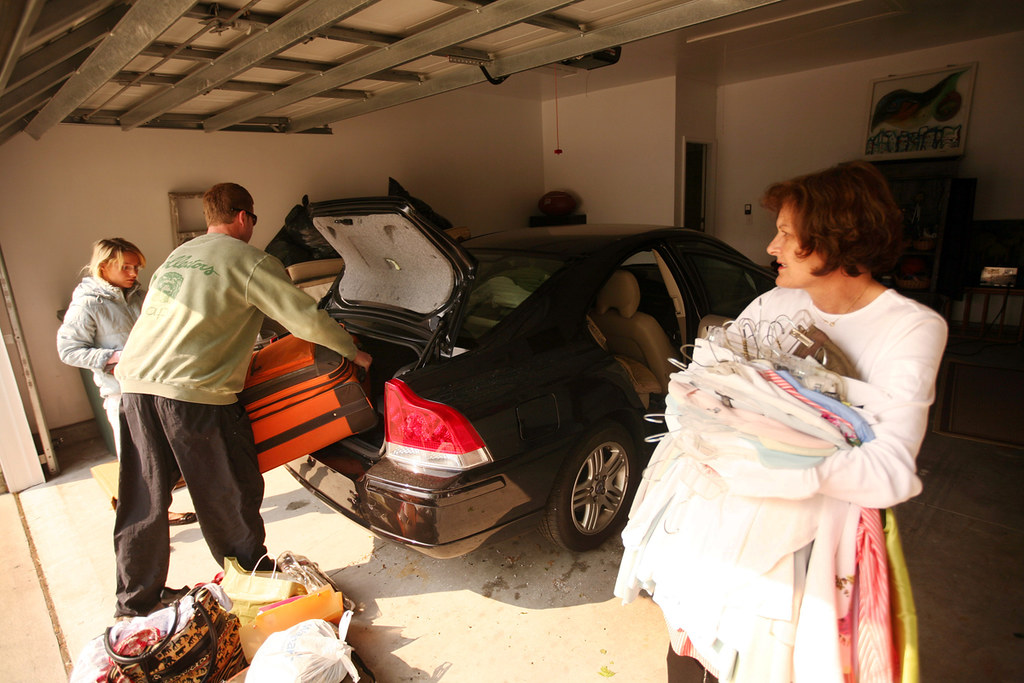
Packing up to evacuate.
It was very eerie – straight out of The Omega Man –
completely empty neighborhoods; some houses with doors still open, or
sprinklers running – trash cans on the curb, awaiting pickup. A low, thin smoke
hung over everything, like a bad Hollywood special-effect of a sinister fog. After
three empty neighborhoods in the subdivision, I came across a bundle of three
houses that had people still in them. I was met by a very friendly man named
Carl King, his wife Georgiana, and his mother Barbara. They were amazing. I
explained what I was doing and he immediately invited me in, gave me full
access to their hectic attempts at packing everything they could salvage into
a small car. They would not stop trying to feed me.
Here these people, perhaps about to lose everything, were taking time and
effort to make me more comfortable. They were amazing, and I am very grateful
to them for their kindness (and their water).
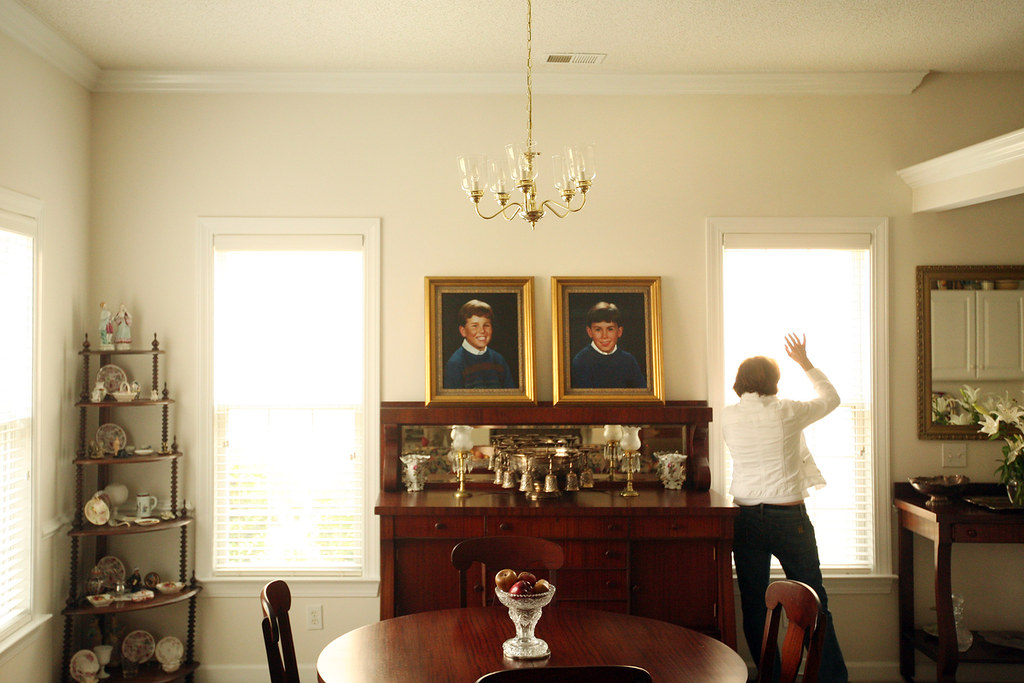
(They kept looking out of the blinds, watching the smoke and fire come closer)
After about an hour, I felt a bit less stressed – I had some decent images of
people reacting. The safe shots of fire trucks and smoke in the distance were
fine, but I had wanted to get something more. With the self-imposed pressure
lessened, I wasn’t in such a pressured mode – now I was thinking about
making images that shared the human element of the story.
I started the 3-mile walk back to my car, and was lucky enough to flag down
a police car relatively quickly to shorten the journey. It was like a scene from
“The Stand” as we zoomed through deserted, hazy suburbs at well over 80 mph.
Once I had transmitted the subdivision images, I started trying to get dramatic
fire shots. Again I was blocked at every turn. Police were not letting anyone within
miles of the active fire zones, and Public Affairs officers with the various fire and
relief agencies called in for the emergency were not allowing press to ride along.
After hours of driving around, trying to get access, I decided to take a completely
different angle: instead of chasing the fire and reacting to it, I would try to get
into a position where IT would come close to ME. I went to an overpass that
was blocked, walked up and scanned the sky for smoke. I noticed the wind
direction, got in my car and took back roads towards the towers of smoke, ahead
of where I thought the wind would drive the flames.
After about 45 minutes of this, I was on a dead-end dirt road with a very defined
tree-line. Huge walls of smoke were rising far in the background. Another journalist,
a TV guy with the same idea, pulled up and we chatted for a minute, sharing our
frustration over being denied by authorities. I remember he said “They are keeping
us so far away – all I have is smoke. If I could just get some footage of actual flames,
that’s really all I need.”
People in the neighborhood had come out of their homes – mostly trailers this far
back – and were watching the smoke, making videos of it, taking pictures. Children
were playing, trying to catch the falling, drifting black ash, which somehow struck
me as the opposite of snow.
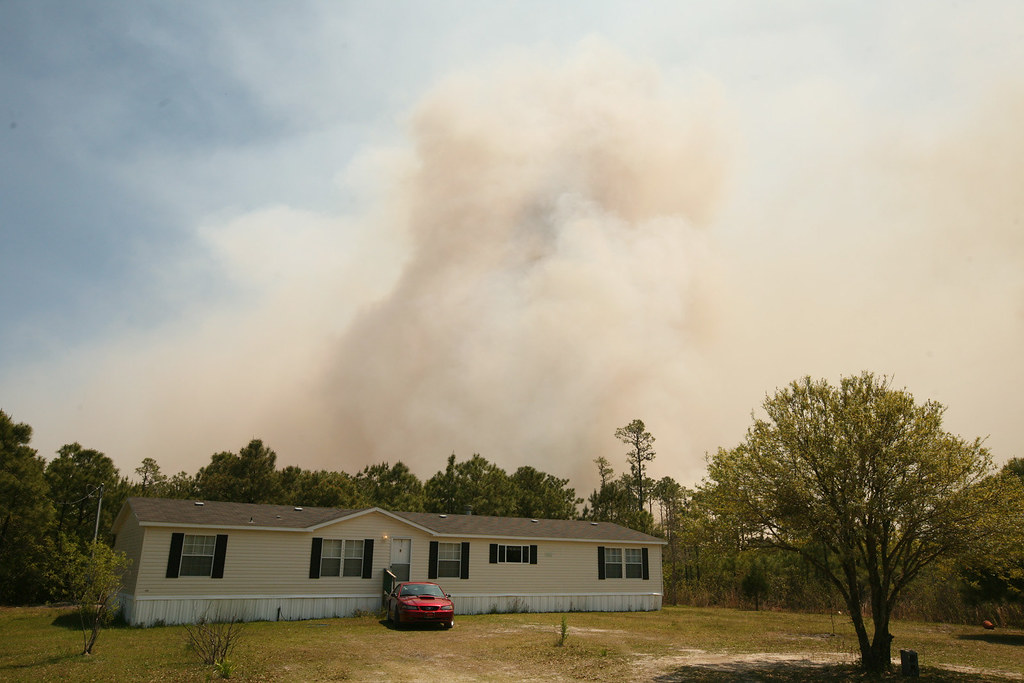
Timestamp from my camera - 12:00:07
I asked some adults if they had a way to leave. They said they did. I asked if
they had enough room in their vehicles for everyone. They said probably. I asked
if they were thinking of leaving soon. Most shrugged. I began mentally figuring
out how many kids I could grab and squeeze into my car. A fire truck slowly
motored down the dirt road. I decided it was time move my car – 1) I didn’t want
to be in the way, and 2) I wanted to be able to get out fast, without having to
do a three-point-turn, reverse, or anything else. I left the keys in the ignition.
I wanted to be able to just jump in and go.
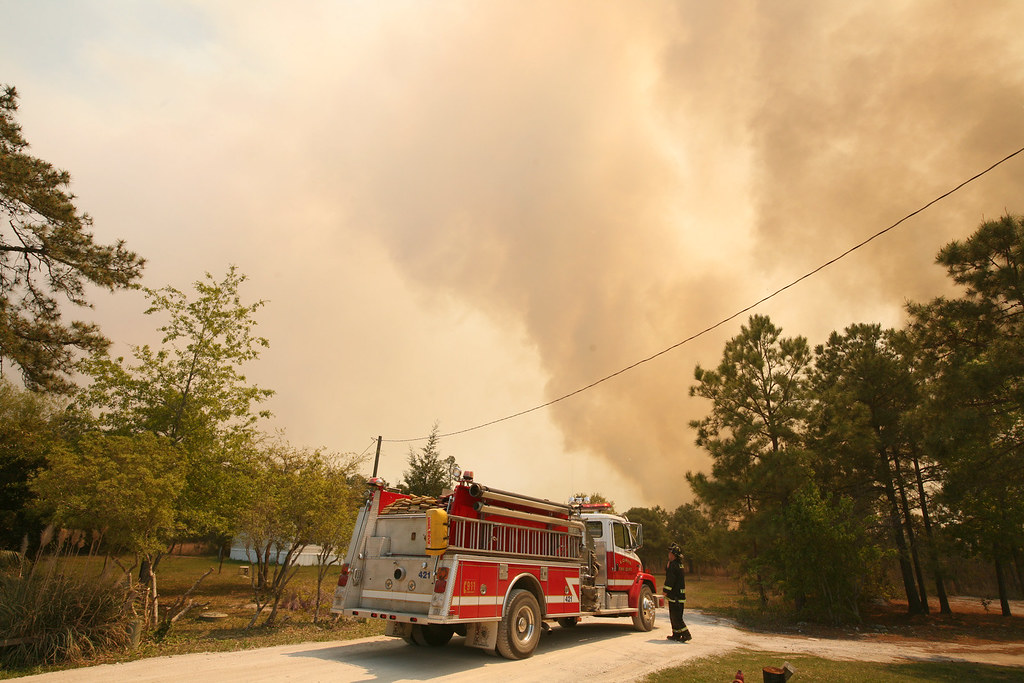
Time- 12:35:05
The smoke was getting closer. Bigger. And it was quickly changing color.
Finally, one woman began to evacuate. Once she left, several other families
took the hint and began to leave. It was obvious the fire was coming this way.
And it was very big. Two men with garden hoses began to spray down their
homes and the areas around them.
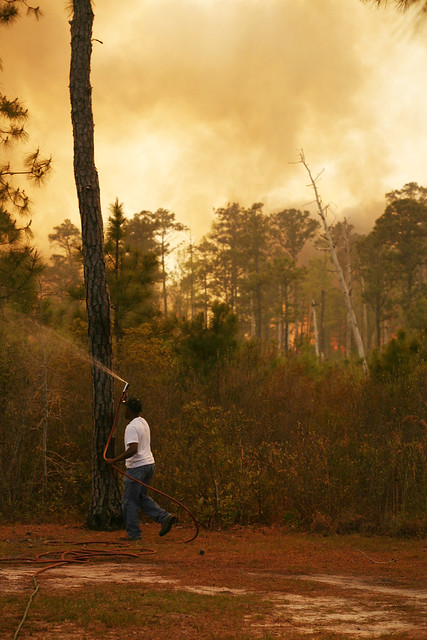
Time- 12:38:04
The three firemen with the fire truck started to unravel two hoses. My pulse
began to really quicken. We got our first glimpse of the flames – they were
as high as the 60-70 foot pine trees around us, with massive tongues licking
even higher. People started yelling, running into their homes, grabbing clothes,
photos - anything they could carry, throwing thing into cars and trucks. I
stood there and took photos. I was sweating. Smoke and ash stung my eyes.
Finally two more firemen showed up – without a truck. They leapt into action
and began helping those trying to evacuate last-minute. And I realized I was
being a leech. I had been just thinking about composition and moment. But
those people, they were not just foreground and background elements of an
image. They are PEOPLE. Yes, I had a job to do, but these people were
undermanned and they needed help. Now. I felt very ashamed that I had slipped
into such a state, so I dropped my camera hanging on my neck and began
running into the homes of strangers, taking whatever they threw at me and
running – throwing clothes and keepsakes into the back of vehicles.

In a matter of minutes everyone who planned on leaving was gone. I picked
up my camera again. I was with three men who lived nearby and one fireman.
We were on the western side of the road; I knew there were three or four
firemen on the east.
Suddenly, the light changed – the mid-day, harsh, bright light turned darker,
softer and a warm hue settled over everything. The smoke was pluming
above us, filtering the sun. The difference was very obvious and fairly quick –
looking at the timestamps on my images, a marked difference occurs in just
over a minute.
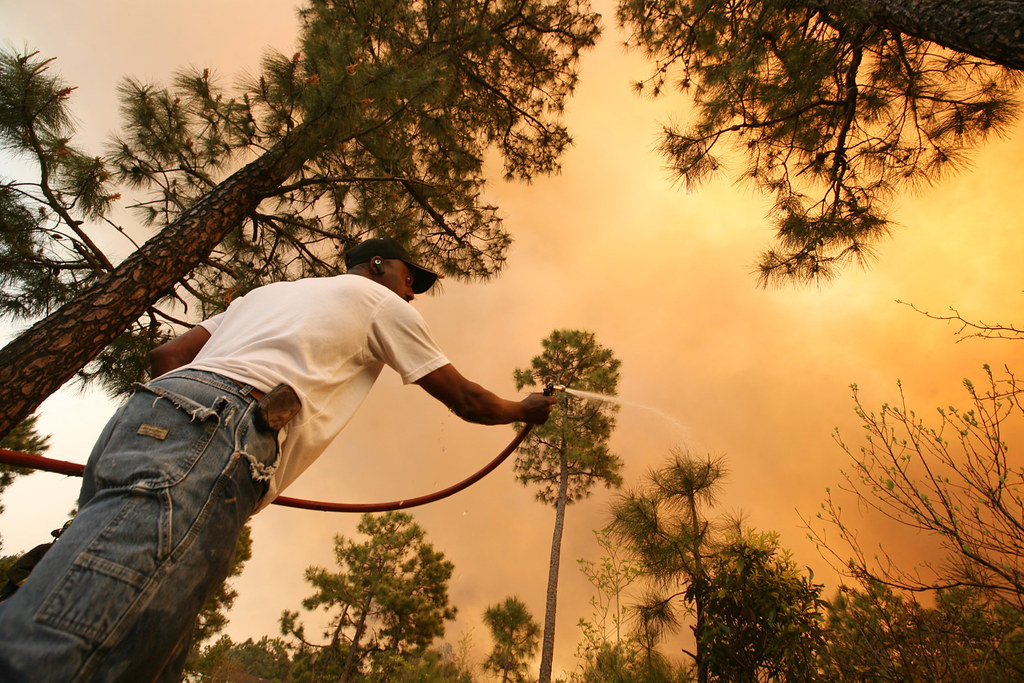
Time- 12:49:10
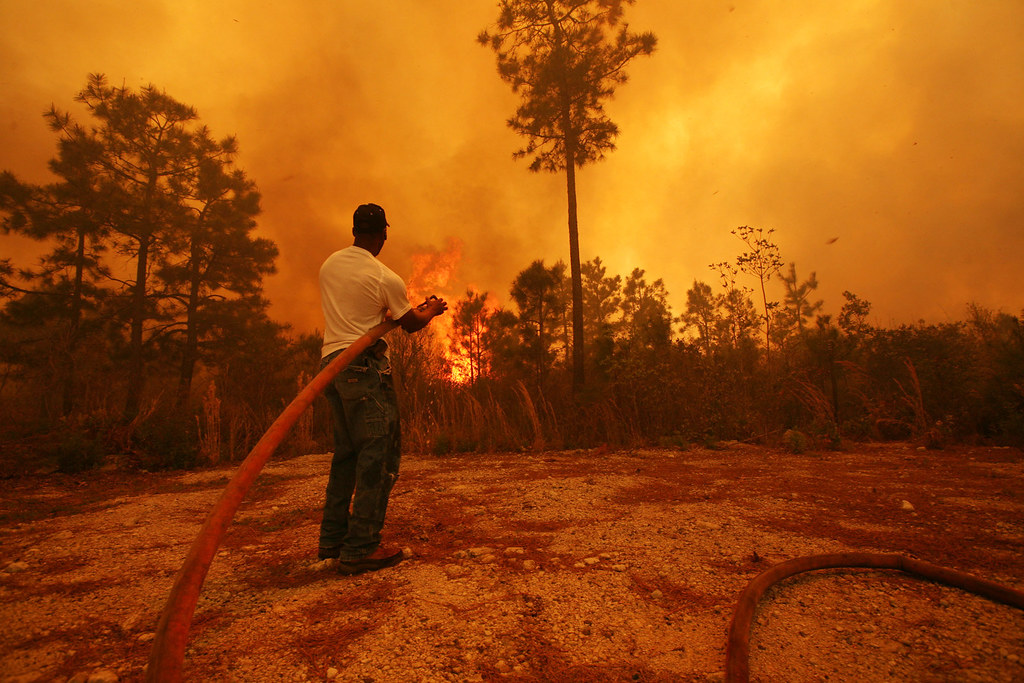
Time- 12:50:20
Then there was an amazing sound and I felt the air change – the wind
that had been blowing the fire toward us rapidly shifted the opposite
direction. The noise sounded like a combination of a giant vacuum and
a lion’s roar. Leaves and debris started blowing by me in little whirlpools
of air. I felt a chill as I realized the sound was the fire feeding; literally
inhaling the oxygen all around in order to grow. And then it was there,
right in front of us.
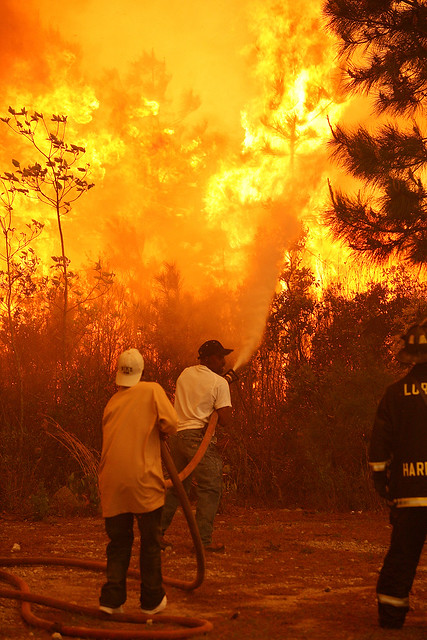
Time- 12:52:44
Again, I knew the change happened quickly, but with my adrenaline
pumping I didn’t know how quickly it really was. Timestamps show how
far the fire traveled in less than three minutes.
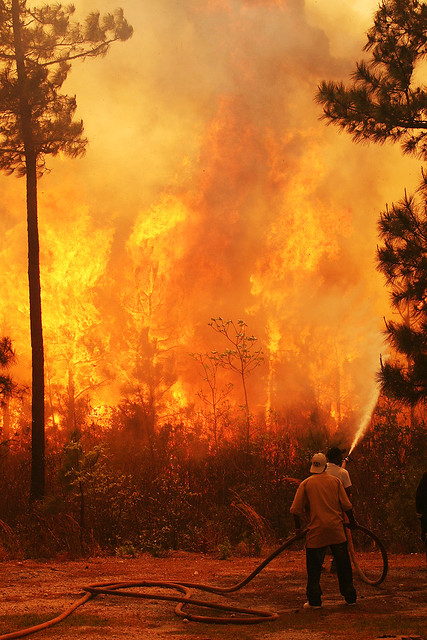
Side note - it wasn’t until I got home that I realized I do not have a
photo that shows the top of the flames - that’s how tall they were.
At once the air turned orange and thick – smoke and ash surrounding,
smothering us. The men started yelling. The flames were here, they
needed water. There were not enough firemen, so the local neighbors
manned the hose, taking directions for the firemen working the water
supply at the truck: ”Don’t start too soon! Spray low!” “Lower! You’re
wasting the water!” “It’s breaking through to your right – 3 o’clock!”
“Move, move – we need more hose!”
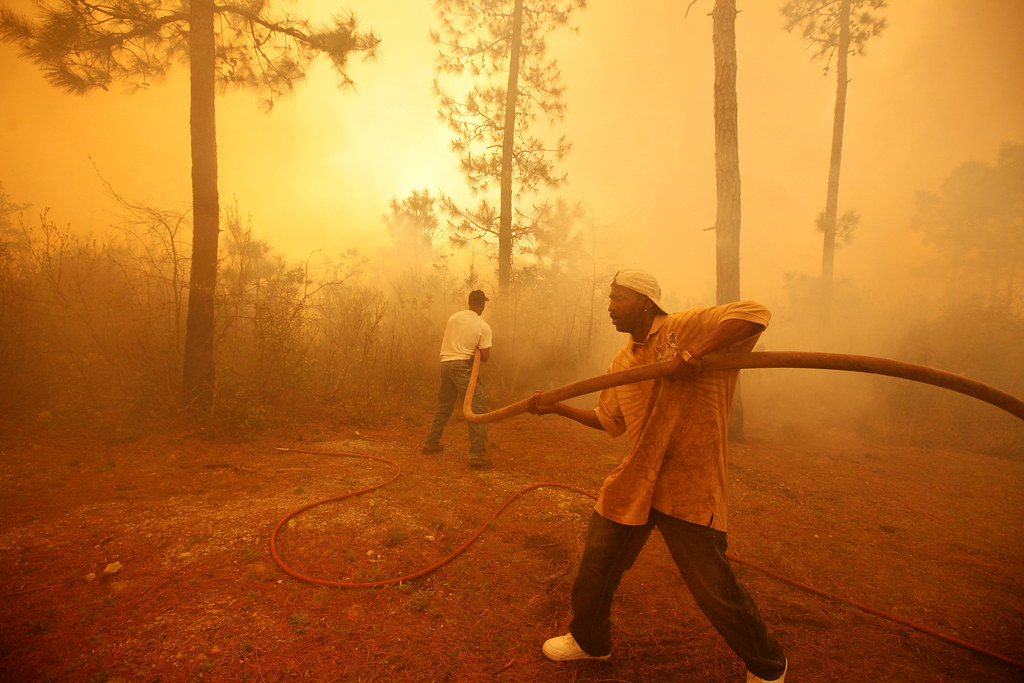

Again, it got to a point where I truly felt I had to put down the camera.
After making some images, I got on a hose, helping move it. I got on
my knees, straining to get it around stumps and other obstacles. I ran
between the two teams trying to help communicate directions. The heat
was amazing – it felt like it was radiating from everything.
The wind switched again. Suddenly, the fire wasn’t just in front of us –
it was now on both sides as well. We started moving back towards the
truck, and when I looked back at the flames, I saw rabbits running out
of the trees and undergrowth - at us, with us, past us. I was now very
scared and remember ridiculously thinking, “Wow. This just got really real.”
This image is when the fellow next to me realized the fire had moved to
three sides around us:
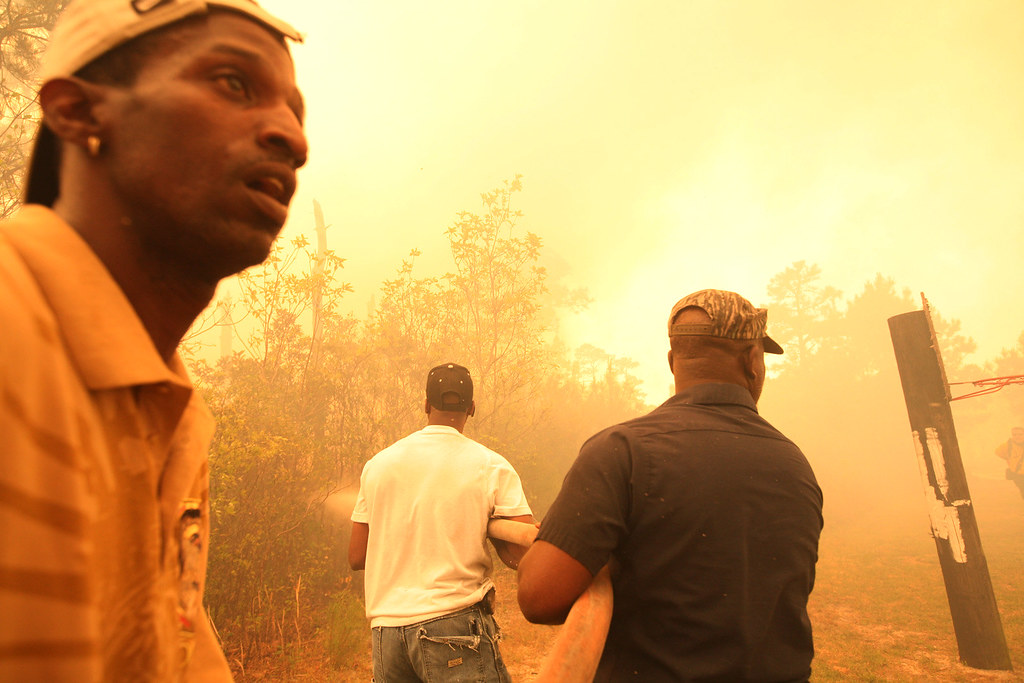
We got to a safer place and the water from hoses started to stall the
flames. I calmed down a bit, and stood looking at the towering fire. I had
to consciously tell myself not to cry. It wasn’t the fear. The only feeling I
can compare it to is when I was present as a friend gave birth. It was a
feeling that was completely overwhelming. I would call it supernatural,
but it was the exact opposite of that – it was a reaction to seeing something
so purely natural, so primal and powerful, the emotional response for me
was something immense. I’ve been through some scary situations- had a
gun pulled on me in the aftermath of Katrina, been in street brawls, tear
gassed, nearly drowned. This was different.
I would love to know how the other men felt. It would be interesting to see
if they were in a similar state, or if I was just being a drama queen – a novice
who was bowled over by his inability to grasp how huge and quick and powerful
this wildfire-beast was. But I didn’t have time to ask, as the fire had changed
direction again, and started toward the home of a family who had not evacuated.
This was a different experience, as women in the family started crying and
screaming. Family members began uselessly pulling at limp hoses that had
no water supply, and couldn’t reach as far as was needed anyway. There was
a bustle of activity as the firemen struggled to get the truck into a better
position. Again, I looked around at the young children wandering around and
wondered if I should start scooping them up and running with them to my car.
A fireman took control and began to order and physically move everyone out of
the area. I followed the families, terrified at the near certainty that they were
going to lose their homes, when a helicopter appeared, dumping water from a basket.
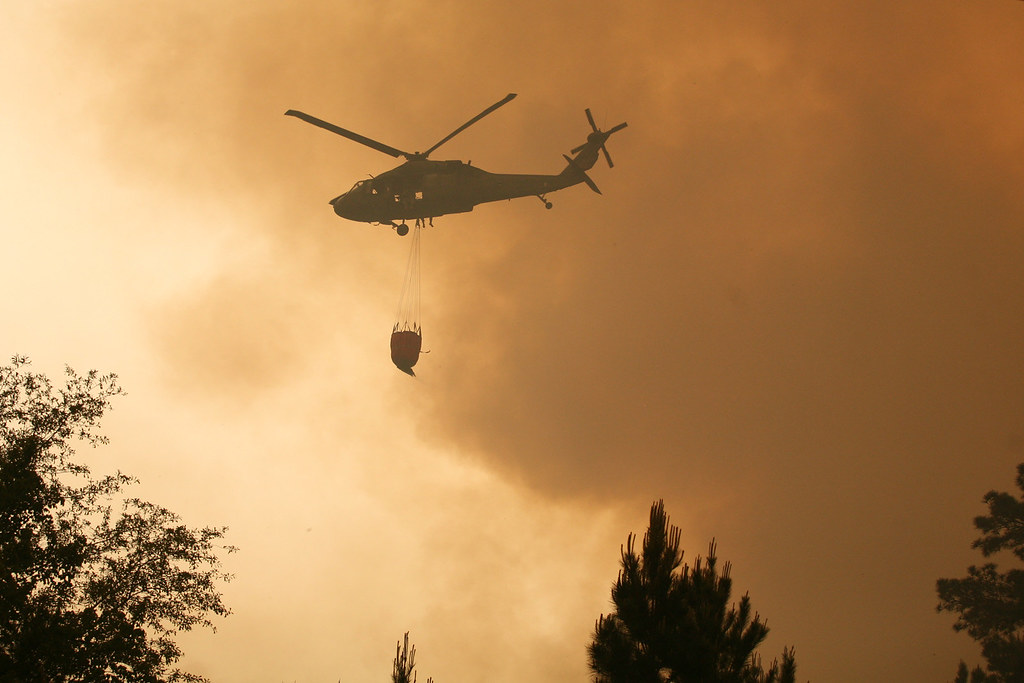
It was an insane symphony – the sounds of the flames crackling, the winds
howling, people crying, the helo’s rotor blades whipping overhead, men
shouting – all mixed with the sound of rushing water from the hoses and
the basket-drops.
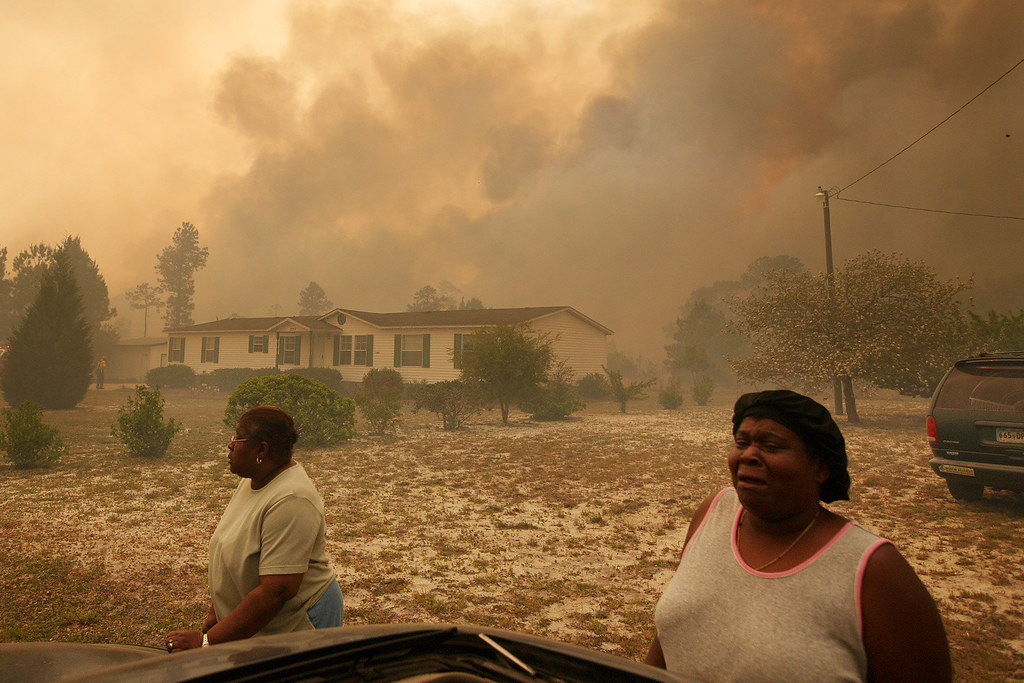
I felt that if I stayed I would be more than a burden – I would be actively in
the way and a distraction to the emergency officials who were working at full
capacity. I followed a family to their car, made sure they could fit everyone
in, took some photos of the exodus, and then got the hell out of there. I
needed to mentally regroup, eat my first real meal of the day, and transmit.
I also wanted to call my dad and tell him I loved him.
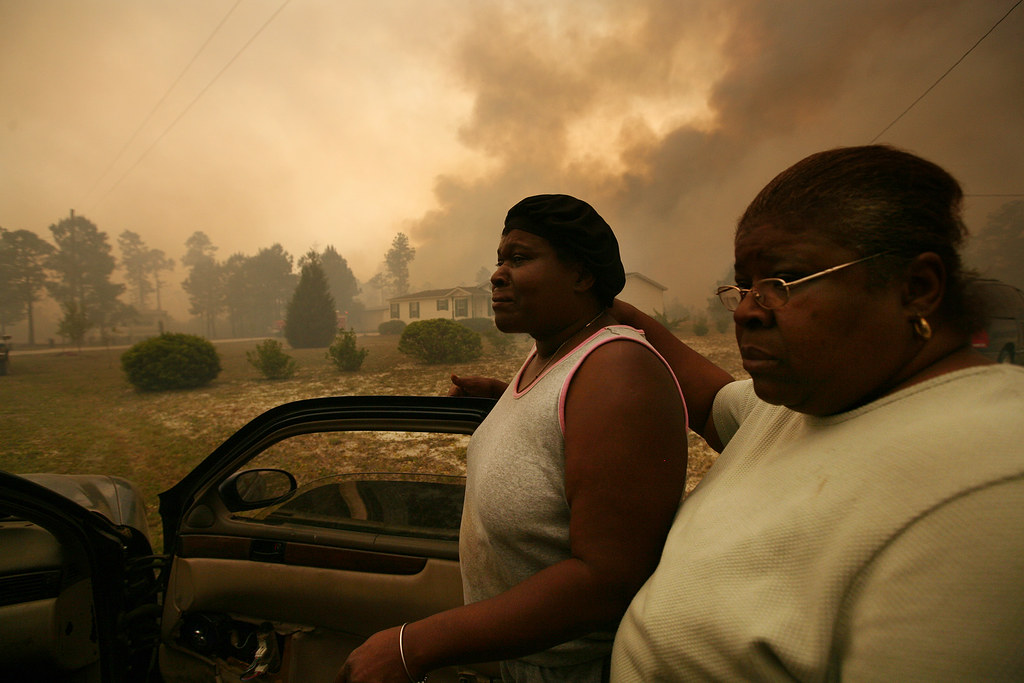
Families evacuating.
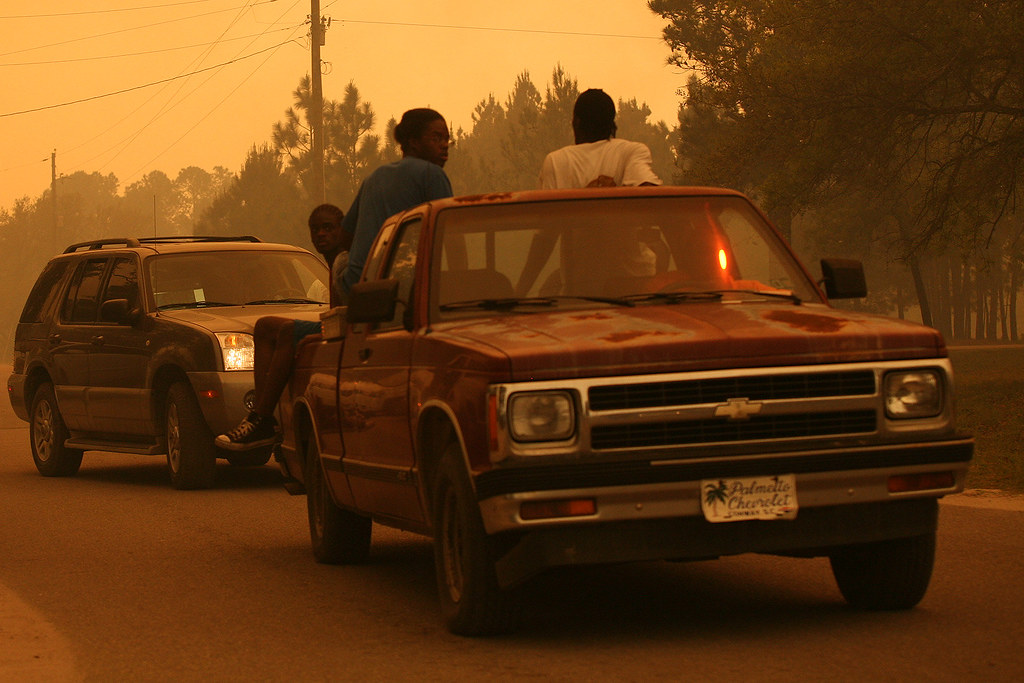
The rest of the day I very much played by the rules spelled out by authorities.
I headed back to Myrtle Beach and stayed close by the shelter, taking the safe
and contained media opportunities offered by the Public Information offices.
By around 7 pm I got the message that the neighborhoods hit hardest by the
fires would most likely be open to the families around 9 am the next morning.
Just to try, I attempted to drive back into one of the areas I knew was hit hard.
More officials denied my entry, and I decided not to push my luck anymore
that day – I would start again the next, with my new knowledge and experience
a cornerstone of planning.
To summarize few of the lessons I learned from this experience:
1) Fires move insanely quickly and erratically. Rabbits, deer and cars cannot
outrun fire. A person doesn't have a chance. You cannot move faster than a
fire, you can only avoid it. If you do not know or understand how a fire moves,
do as much research as possible and travel with someone who does have
firsthand knowledge of what to look for in its movement and patterns.
Most bystanders do NOT understand how fast a fire can move. If you feel
uncomfortable in a situation, don't let others' staying hold you back. Get
out when (if not before!) you feel the need to get out.
2) DO NOT try to cover something like this on your own or without expert
guidance. Many of my decisions that day were reckless and stupid, and I
was very lucky. Read up, ask questions, work alongside and with those who
have experience. Another pair of eyes to watch your back and give advice on
developments can be invaluable.
3) Covering fires can be a very strenuous activity. Make sure you are eating,
staying hydrated, and at a decent energy level. If you need a break, get out
and recoup. Transmit, check out other images on the wire, look at maps,
etc. There is a LOT that can be done while you physically recharge.
4) Little things can make a big difference. Like my example with the car -
leave keys in the ignition when you get out of your vehicle. Not only do you
want to be able to jump in and go, but you also do not want to block others.
5) Know where you are (i.e. roads and routes), and multiple ways to leave. You
don't want to end up on a dead-end road, stuck behind other vehicles as a fire
approaches. Be aware of all vehicles that could be used in a quick exit.
6) Be safe, be true in purpose to yourself, viewers and subjects. That is so much
more important than an image.
PostScript: Since this story was originally written, Sportsshooter.com has
featured another great article by Rafael Agustin Delgado called
"Into The Fire" about safety in covering wildfires - A highly recommended read.
+++++
Logan has photographed in over a dozen countries for a wide variety of
editorial and advertising clients. His images have been published in books,
magazines and newspapers all over the world, including: TIME, Newsweek,
National Geographic Adventure, WORLD Magazine, People Magazine, USA
Today, Los Angles Times, The Guardian (London), as well as on the front
page of the New York Times, Chicago Tribune, Washington Post and the
International Herald Tribune.
He's been recognized with several national and international honors and
grants, including awards in Pictures of the Year International, NPPA's Best
Of Photojournalism, the Alexia Foundation for World Peace, National Hearst
Competition, the Public’s Best Picture of the Year Award on MSNBC, and
North Carolina Press Photographers Association.
You can view his work at:
http://www.loganmb.com/
+++++
Next week on TID, we'll take a look behind this wonderful image from
Johnny Andrews from a fashion shoot:
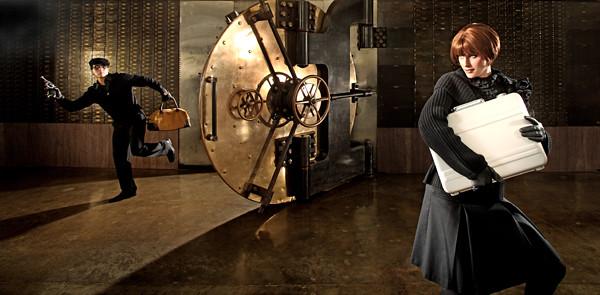
As always, if you have a suggestion of someone, or an image you
want to know more about, contact Ross Taylor at: ross_taylor@hotmail.com.
For FAQ about the blog see here:
http://imagedeconstructedfaq.blogspot.com/
No comments:
Post a Comment